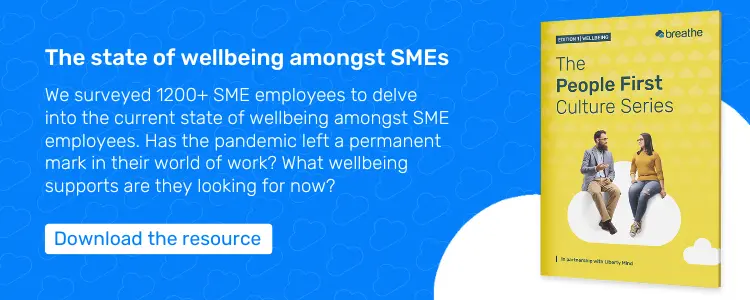Employers have a duty of care for all employees, but there are additional requirements they must consider in the case of pregnant women and new mothers.
Maternity risk assessments are a legal requirement and if a pregnant woman or a new mum is combining home working with a return to a business’ premises, then employers must assess both environments to ensure their employees are as safe as possible and free from risks.
In this article we examine the requirements and set out a blueprint for a carrying out a maternity risk assessment and recording the results, in addition to detailing steps to mitigate any risks which are identified.
Skip to:
- What is a maternity risk assessment?
- Are maternity risk assessments a legal requirement?
- When should maternity risk assessments be carried out?
- Common risks for new and expectant mothers
- Do I need to carry out maternity risk assessments for home-workers?
- Rest and breastfeeding at work
- Using risk assessment templates
- Recording Maternity Risk Assessment findings
What is a maternity risk assessment?
A maternity risk assessment is the process of identifying what hazards currently exist or may appear in the workplace.
A risk assessment defines which workplace hazards are likely to cause harm to new or expectant mothers. The assessment covers an organisation’s workplace and also homeworkers’ own environments.
Are maternity risk assessments a legal requirement?
Yes they are. As set out in the Health and Safety at Work Regulations 1999, risk assessments are a legal requirement for all businesses across all industry sectors. They apply to all employees but employers must take extra measures to protect pregnant women and new mothers, taking the stage of their pregnancy and their health into consideration.
The Health and Safety rules stipulate that new or expectant mothers include pregnant women, women who have given birth within the previous six months and women who are breastfeeding.
Maternity risk assessments also apply to any sub-contractors you employ. If you employ a self-employed contractor who is a new or expectant mother, you will both have duties under health and safety law and need to agree on the risk assessment and any measures required that ensure safe working.
Every employee is protected from workplace discrimination due to the Equality Act 2010. However, additional rights may apply to pregnant staff.
A pregnant employee has the right to take time off work for antenatal appointments, including the time to travel to the clinic or GP, without loss of pay. This also applies to any employee who has a doctor’s appointment of any kind. You can’t ask the pregnant employee to make up the time or to arrange the appointment for a time outside of their working hours.
If an employee declares a task too risky, you cannot dismiss them for not undertaking the work properly. You should take another look at their risk assessment and modify it accordingly.
When should maternity risk assessments be carried out?
Once you know an employee is pregnant, a new mother or breastfeeding, you should have regular health and safety related discussions with them and these should include planning an ongoing series of risk assessments.
You should consider:
-
Possible risks that may occur at different stages of pregnancy
-
Medical advice the employee has received
-
The type of work they do
You must temporarily change the employee's working conditions or hours, if both of the following apply:
-
The risk assessment or subsequent discussions with the employee show that risks exist
-
The risks cannot be reduced or removed
Common risks for new and expectant mothers
The most common risks from working conditions for new and expectant mothers include:
-
Standing or sitting for long periods
-
Lifting or carrying heavy loads
-
Long working hours
-
Temperature
-
Working at height
-
Workstation and posture issues
-
Work-related stress
There are also risks through exposure to:
-
Lead
-
Radioactive material
-
Toxic chemicals like mercury and pesticides
-
Carbon monoxide
-
infectious diseases including COVID-19
More detailed information about the different types of risk is available in the annexes of the Pregnant Workers Directive 92/85/EEC.
Do I need to carry out maternity risk assessments for remote workers?
Yes you do. The requirement for assessing risks in a pregnant or new mother’s home working environment is every bit as important as your office or work-place. Any accidents or incident which harm a new or expectant woman (or her child) while working from home need to be recorded.
Risk assessments should include an audit of a homeworkers’ workstation to ensure these are suitable for extended periods of work. Workstation assessments should include office furniture such as desks and chairs to ensure these pose no risk to a woman’s posture.
Recently updated Health and Safety Executive regulations apply to workers who use display screen equipment (such as laptops, tablets and smartphones) daily, for more than an hour at a time.
These rules apply to DSE users who work onsite and for those who work from home on a full or part-time basis. Employers are required to complete DSE assessments for homeworkers and their office-based people.
Rest and breastfeeding at work
Workplace regulations require employers to provide suitable facilities where pregnant and breastfeeding mothers can rest. The Health and Safety Executive (HSE) recommends that it's good practice for employers to provide a private, healthy and safe environment for breastfeeding mothers to express and store milk.
Using risk assessment templates
The Health and Safety Executive provide an excellent set of downloadable risk assessment templates which have been tailored to businesses which operate in different industry sectors. These cover:
-
Who might be harmed and how
-
What you're already doing to control the risks
-
What further action you need to take to control the risks
-
Who needs to carry out the action
-
When the action is needed by
Recording maternity risk assessment findings
If you employ 5 or more people, you must – by law- record your significant findings, including.
-
The hazards (things that may cause harm)
-
Who might be harmed and how
-
What you are doing to control the risks
To record your findings, consider using a dedicated HR management software system such as Breathe which includes document management functionality. Your completed risk assessments and details of measures taken to mitigate risks can be stored within one single system where it can be accessed by employees, their managers and your company’s leadership team.
If an expectant or new mother is injured or becomes unwell during working hours, you may need to demonstrate what you have done in terms of completing a risk assessment and the steps you have taken to mitigate risks.
You may also find Breathe’s parental rights guide useful. This examines employment law and discusses the steps businesses can take to create supportive, family friendly environments and accommodate flexible working.
Finally, Maternity Action - the UK’s leading maternity rights charity – provides detailed guidance for employers and employees and it highly recommended as a resource you can offer to new and expectant mothers.

Author: Aimée Brougham-Chandler
An IDM-certified Digital Copywriter as of February 2023, Aimée is Breathe's Content Assistant. With a passion for guiding readers to solutions for their HR woes, she enjoys delving into & demystifying all things HR: From employee performance to health and wellbeing, leave to company culture & much more.
.webp)



